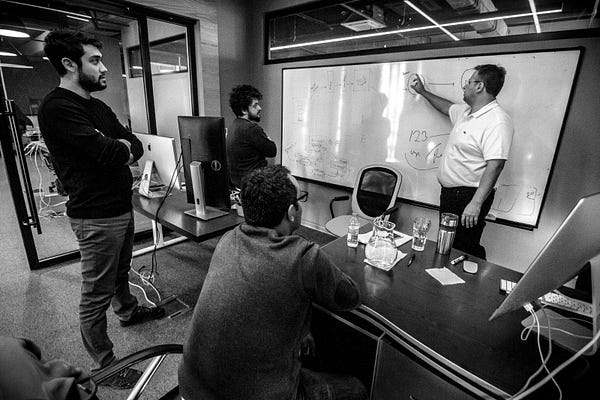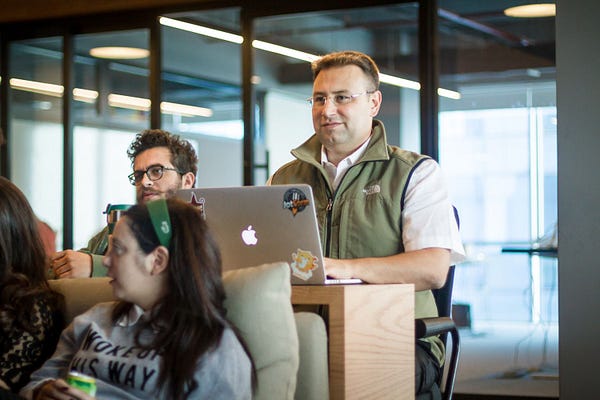Slow and steady wins the race

I shut down my computer and glanced at my desk calendar.
It was January 23, 2011. My company, JotForm, was five years old.
We had six employees, including some terrific designers and developers who spent their days improving and evolving the product.
As the founder and CEO, you might think I was focused on strategic growth. Maybe you imagine spreadsheets and acquisition charts and high-level financial meetings.
The reality?
I was doing customer support — all day long.
From the moment I sat down at my computer until the end of the workday, I answered hundreds of emails and customer questions.
And it was just me. I was a support department of one.
As I locked up the office on that cold day in January, I knew something needed to change.
I had built JotForm without any funding or investments. I took pride in our slow and steady climb, but this was getting ridiculous.
I placed a job ad the very next day.
By the end of 2011, I had replaced myself with nine customer support staff.
The benefits of a slow-burn startup
Hiring those employees was a good decision — and one that eventually helped us to attract 3.2 million users, but clearly, I didn’t rush it.
By the time I placed that ad, we not only needed the help, but I also had the resources, experience and wisdom to hire great people and nurture our culture.
Today, JotForm has 100 employees across the world. We’ve continued to grow slowly and consciously.
Many startup experts will tell you to hire fast and fire faster. This advice gets even louder when VC money is in the mix.
When you land a major investment, there’s pressure to grow exponentially and hire a full team — right this minute.
I’ve already shared some of my bootstrapping journeys and offered an alternative path to building a startup without raising funds.
I believe that growing slowly is a great way for entrepreneurs to maintain their sanity and their personal lives while creating a viable (and potentially more satisfying) business.
It can also help you to build a fantastic team. Here’s why.
1. You wear all the hats, and you learn how they fit
I launched JotForm in 2006 as a free product. When it was time to build a premium version, I hired my first employee.
By that point, I knew exactly what kind of person I wanted to find. I knew what skills and attributes would complement my own.
Almost a year later, I hired a full-time designer. I had been doing all the design work myself, so once again, I knew what skills we were seeking.
The same scenario played out with our marketing team, accountants, and just about every other employee we’ve hired.
As a bootstrapped founder, I’ve tackled design, development, support, marketing, HR, dishwashing and office cleaning.
I’m not trying to present myself as some kind of martyr; it’s just the truth. And it means that I really understand each role.
That’s a major advantage when it’s time to pass the baton.
2. You can learn and grow with your team
Back in 2006, I was a developer, not a leader.

I had no idea how to manage or motivate people.
When it was just our first employee and I in the office, we ate lunch together every day. We talked and shared ideas, and I discovered what made him feel productive and engaged.
Slowly, I learned how to collaborate, while also serving as “the boss.” It was on-the-job leadership training.
To be clear, I’ve also made a ton of management mistakes. I’ve hired the wrong people. I’ve sometimes failed to provide what my employees needed.
And the first time I had to fire someone was incredibly scary. But, without investor pressure or an instant team of 60, my mistakes were small. They didn’t have huge repercussions.
When a majorly-funded company like Medium has to lay off a third of their staff, that’s an amplified mistake. It deeply affects lives and businesses. There’s real freedom in learning slowly and growing with your team.
3. You can develop an effective onboarding style
Every new JotForm hire goes through Bootcamp.

I can’t take credit for this idea, because we stole it from Facebook and Zappos, but here’s how it works in our business:
In their first month, new employees handle at least 100 customer support requests.
It’s the best way to understand our users, their struggles, and their product needs. It also ensures that new hires know every nook and cranny of the software.
After all, you can’t help someone if you don’t understand the product’s inner workings — and most employees say that this hands-on support time proved to be invaluable.
New team members also serve as co-pilots. They spend at least two hours a day, for a couple of weeks, working alongside another developer or designer or marketer.
They watch and ask questions. They see firsthand how our employees tackle their roles. Not only do new people learn important skills, but the process quietly strengthens our culture.
New team members (hopefully) absorb values like openness and honesty and a willingness to take risks.
Our Ankara office is on a local university campus. It’s a pretty beautiful place to work, so I also try to go for long walks with our new employees and take them to lunch.
Also Read: KBank’s VC arm Beacon invests in Thailand’s proptech startup Horganice
In the San Francisco office, we take long walks on the Embarcadero taking in the relaxing bay view. I share stories about JotForm and we get to know each other.
Relating to people on a human level matters to me, and it uncovers what they’re hoping to achieve in our company.
Sometimes we’ll hire someone for one position and find they’re better suited to a different role.
I wouldn’t be able to spend this kind of one-on-one time with new employees if I had to go on a massive hiring spree.
4. You can establish deep cultural roots
Startup culture is such a hot topic.
Many successful entrepreneurs say that culture is the foundation of their companies. I didn’t always understand why, but I do now.

JotForm has a culture of continuous improvement. I’ve been heavily influenced by the lean startup philosophy and leaders like Eric Ries.
Many software companies have monthly or six-month release cycles, but we try to release product changes immediately.
It can be a culture shock for new employees, but they soon embrace the chance to directly affect our product.
It’s empowering. And it shows that their work will make a difference.
We’re so committed to continuous improvement that we ask new hires to release a product update on their very first day.
Sometimes they’re apprehensive, but we try to ensure everything is prepared and we’re ready for their input. We streamline their onboarding and provide a challenge that can lead to immediate changes.
The beaming smiles we see at the end of the day are an awesome reward.
I love the sense of pride that hands-on action can create. Even when we hit a roadblock, we want our team to know that they are here to innovate and learn.
They can make meaningful contributions. I’m not saying we’re perfect, but it’s a technique we’ve developed to nurture our culture, and it took some time to get here.
5. You can cultivate strong, productive teams
Our company works in cross-functional teams.
Instead of creating silos, we have 5–6-member teams comprised of a developer, designer, UI expert, data scientist, and any other roles the group needs.

Most new hires tell me that they haven’t worked this way before, but I think it promotes better collaboration.
Each project has multi-functional input from start to finish, which means that every angle is considered. Small bugs or mistakes don’t multiply into major challenges.
An agile workflow also brings everyone together in a large space to share our screens and demonstrate what we’re working on. Everyone contributes.
We encourage each team member to comment, ask questions and suggest new ideas.
Slow team growth can be your competitive advantage
I’ve learned what works for JotForm, but what works best for you?
Developing the right style takes time.
Also Read: AirAsia launches US-based VC fund, strategic partnership with 500 Startups
Bootstrapping gives you space and freedom to do it your way and grow on your schedule.
I’ve listened to my employees over the past 12 years and learned what they want and need. I can’t say I always deliver, but I try — and that has also helped us to attract amazing people in a competitive market.
We believe in providing an amazing product. We also believe that everyone deserves to live an amazing life. We work hard to make our customers happy, but our company doesn’t glorify the 24/7 hustle.
We make mistakes and we try to fix them. We’re always trying to improve.
Oh, and I still do some customer support now and then, but I usually leave that to the professionals on our team. They’re much better at it than me.
After 12 years in business, that’s a great feeling.
—
This article was originally published on Jotform
e27 publishes relevant guest contributions from the community. Share your honest opinions and expert knowledge by submitting your content here.
The post Hire slowly, grow slowly: how we grew from 1 to 100 employees appeared first on e27.